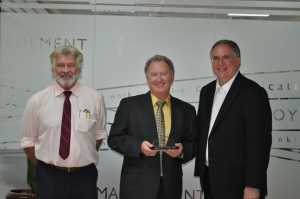I was intrigued by many things about the country and the people, but these things deserve some special mention about my visit to the United Arab Emirates.
 1. Derek Zoolander would feel right at home. Zoolander couldn’t turn left on the runway with all the other incredibly-good-looking male models. Neither can the Emerati. If you want to make a left turn while driving down a street, you generally have two choices: 1) maybe you’ll get lucky enough that your desired street is one of the nodes of a roundabout, or 2) more likely you will have to drive past the street where you would like to turn left until you get to a designated U-turn lane (see pic) and then proceed back to the street which is now a right turn. The major streets and the highways are all designed this way.
1. Derek Zoolander would feel right at home. Zoolander couldn’t turn left on the runway with all the other incredibly-good-looking male models. Neither can the Emerati. If you want to make a left turn while driving down a street, you generally have two choices: 1) maybe you’ll get lucky enough that your desired street is one of the nodes of a roundabout, or 2) more likely you will have to drive past the street where you would like to turn left until you get to a designated U-turn lane (see pic) and then proceed back to the street which is now a right turn. The major streets and the highways are all designed this way.
2. Cell phone ownership – I heard from more than one person that the number of cell phones per capita is 2 or more. That seems crazy, right? It is true that everyone seems to have a cell phone, but why would they have two mobile phones (on average, which means that some have more than 2)? My UAE friends tell me that the young Emirati women often carry multiple phones – one for communicating with their family members, and one or more others for communicating with people that their family doesn’t want them talking to (men/boys, of course). Seems like quite a game of cat and mouse.
 3. The garbage strewn all over the countryside is very sad. Apparently there is no fine for littering and very little effort to stop the continuous disposal of trash anywhere and everywhere. I tried to get a shot of some of the trees that have 6 or more of the national flowers on them – where the national flowers are brightly colored plastic bags that get caught in the trees like one of Charlie Brown’s kites. While taking this photo of the camel, another camel off to the left was barfing up a green plastic bag that he had swallowed. Very sad.
3. The garbage strewn all over the countryside is very sad. Apparently there is no fine for littering and very little effort to stop the continuous disposal of trash anywhere and everywhere. I tried to get a shot of some of the trees that have 6 or more of the national flowers on them – where the national flowers are brightly colored plastic bags that get caught in the trees like one of Charlie Brown’s kites. While taking this photo of the camel, another camel off to the left was barfing up a green plastic bag that he had swallowed. Very sad.
4. They are tearing down mountains all over the Emirate of Fujairah. Sort of like clear-cutting the rain forest in a tropical country, they are bulldozing mountains in the name of progress. Seems to be multiple reasons for this. Some of the mountains are being leveled because they want some flat land for building purposes. Also, the rocks have a sales value – apparently they are selling it for various purposes, including the construction of the “palm islands” on the Persian Gulf and the Gulf of Oman.
 5. In Fujairah, they continue the long tradition of bull-butting on Friday afternoons. Also called bullfighting, this is very different from the Spanish or Mexican bull fights with man versus beast. These are tests of strength with bull-versus-bull. The day that I was there was some sort of end-of-season championship. We watched about five of the bouts and then left since I needed to get to the Dubai airport that evening. Unfortunately we left just before a huge brawl broke out that would have been quite a scene. As my friend Andrew writes: “apparently shortly after we left a fight broke out between two opposing teams, which eventually developed into a crowd free-for-all. Fujairah is scandalized as something like this has never happened in the history of bullfighting in the city.” Rats.
5. In Fujairah, they continue the long tradition of bull-butting on Friday afternoons. Also called bullfighting, this is very different from the Spanish or Mexican bull fights with man versus beast. These are tests of strength with bull-versus-bull. The day that I was there was some sort of end-of-season championship. We watched about five of the bouts and then left since I needed to get to the Dubai airport that evening. Unfortunately we left just before a huge brawl broke out that would have been quite a scene. As my friend Andrew writes: “apparently shortly after we left a fight broke out between two opposing teams, which eventually developed into a crowd free-for-all. Fujairah is scandalized as something like this has never happened in the history of bullfighting in the city.” Rats.
6. There are more people in New York City than in all of the UAE. The population is currently between 6 and 7 million people. One reason I bring this up is that the country feels much more heavily populated than it actually is. Abu Dhabi and Dubai are both large, bustling cities with approximately 1 million residents each, which must give me the impression that there are a lot of people living here, which there isn’t. The other really interesting thing is that the native Emirati people make up 20% or less of the total population. Expatriates come from all over the globe and in increasing numbers. It is an incredible melting pot of people.
 7. The Dubai financial collapse has left an unbelievable number of partially completed building sites scattered across the landscape. The number of construction cranes is simply astounding, yet many of them appear to be sitting idle while they wait for economic recovery. Even where construction continues, it seems to continue at a snail’s pace. Several buildings have reportedly been under construction for 3 or 4 years, with very little noticeable progress being made. It does appear that a great deal of the labor is done by hand, which seems to make for a long and arduous process.
7. The Dubai financial collapse has left an unbelievable number of partially completed building sites scattered across the landscape. The number of construction cranes is simply astounding, yet many of them appear to be sitting idle while they wait for economic recovery. Even where construction continues, it seems to continue at a snail’s pace. Several buildings have reportedly been under construction for 3 or 4 years, with very little noticeable progress being made. It does appear that a great deal of the labor is done by hand, which seems to make for a long and arduous process.
8. They have some very interesting customs and/or religious beliefs when it comes to polygamy, drinking alcohol, male/female interactions, tribal warfare, work ethic for young men, and a host of other things. However, if I said too much about any of these things then I would probably never be invited back, So I won’t do that.
For the record: I loved it there. Had a great time and would go back in a heartbeat.
Filed under: Asia-Trips | Tagged: UAE | 5 Comments »











